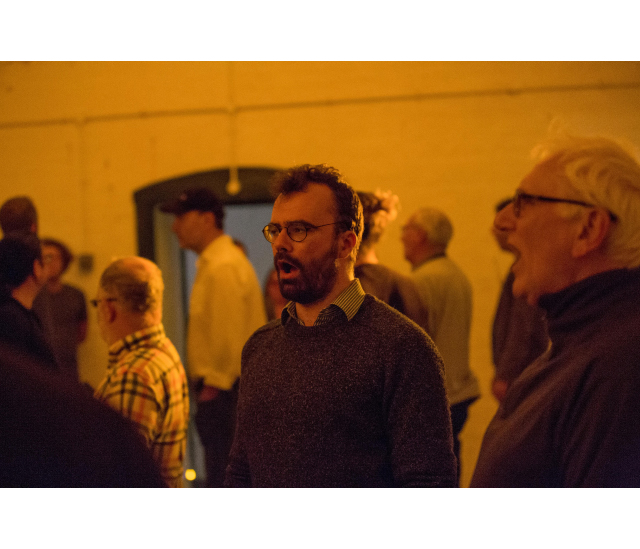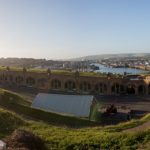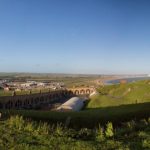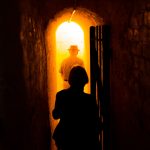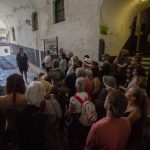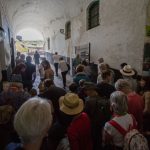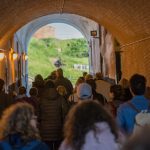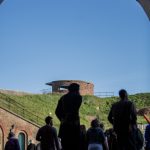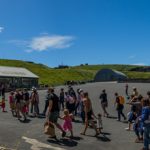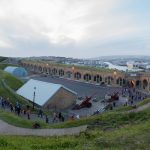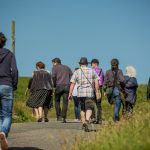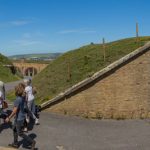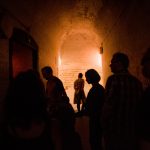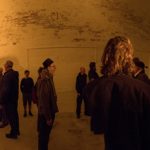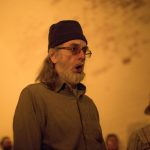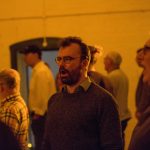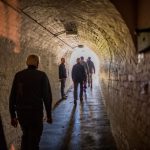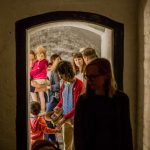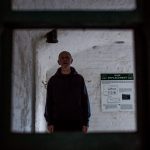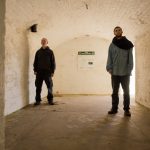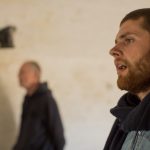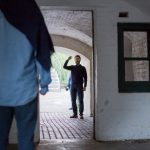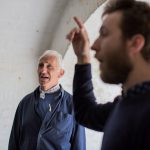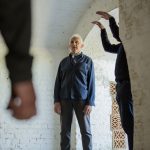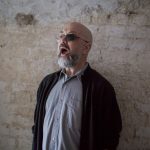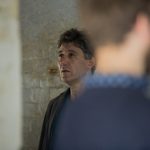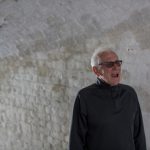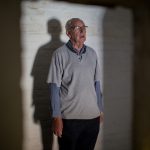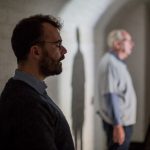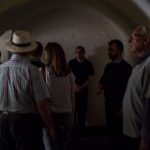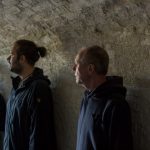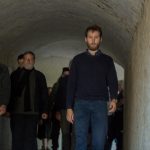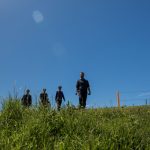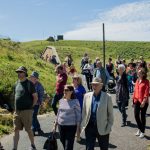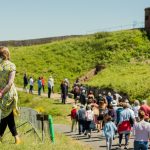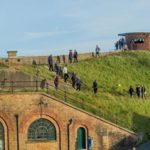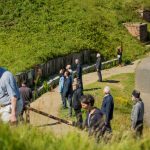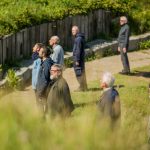Verity Standen’s Refrain was an immersive, choral experience performed at Newhaven Fort.
Refrain was inspired by the story of conscientious objectors at Richmond Castle and was developed for sites of specific historic importance for conscientious objectors during the First World War.
As part of its tour Refrain was performed at Newhaven Fort from 9-11 June 2017. The play was composed and produced by Verity Standen, and below she discusses her motivations and the process of creating the piece.
Richmond Castle, North Yorkshire is such a key site in our understanding of conscientious objectors because the cell block retains original graffiti drawn by the men who were held there in 1916. I was lucky enough to spend time in the cells, surrounded by these 100-year old marks: drawings, poems, biblical verses, political statements and memories of life outside. But the Richmond Sixteen are just a tiny part of the story of conscientious objection – around 16,000 men refused service on grounds of conscience in WW1. The Richmond Sixteen were a group of 16 conscientious objectors who were taken to France and sentenced to death for refusing orders, but who eventually had their sentences commuted to life prison sentences and hard labour.
We began our conversations about staging the work in St Helens when we discovered the story of Ernest Everett, a school teacher from the town who was the first person to be convicted for refusing to fight. It’s a personal story that really resonated with the whole team. And it felt important to find a site for Refrain on the South coast, where many of the conscientious objectors were sent to work camps before being shipped to France to face court-martial. Newhaven, close to the Seaford camp and with its own military fort, completes our trio of venues.
In each place I wanted to find a site that was connected to the history, but that in its own right offered an adventure for local performers and audiences – a range of spaces and scales, natural acoustics that support the voice so that the audience’s relationship to the sound could be live and direct rather than amplified.
English Heritage guided me in the first instance through the histories and I used a set of informative (and dense) books on conscientious objection, recommended by curator Kevin Booth, as a jumping off point. It was a topic I knew very little about; I was shocked to learn of the visceral disdain and shame put upon the men by some sections of the media and society. For a considerable time after they were released from prisons around the country, their choices marked them.
As part of this homework, it felt very important to spend time at the sites and get a sense of how all the different spaces feel and sound. While I was keen to learn about the histories, I knew that I wanted the heart of the piece to remain in the here and now – made with, and performed by, local people. Richmond Castle for instance, has a wonderful range of acoustics – from the intimate chapel to the great, reverberant keep – that I wanted to fill with the voices of local singers.
Parts of the site are nearly 1,000 years old and open to the elements, so there’s the weather to contend with too. I’ve tried to keep both the history and the environment in my mind while I compose.
We all react to music in different ways: two people can listen to the same series of chords and one find it melancholic while the other hears it as totally uplifting. There will be a series of spaces
across the locations to explore, each filled with voices. I want the audience to make their own journey, to spend as long as they like in each space and savour the varied sounds that the men are
creating.
I imagine some people will enter those spaces, having read about the inspiration for the work, with the historical context at the forefront of their experience. Others might purely
enjoy spending time in those environments. I hope that the music can function as a guide through the experience – gently leading people on an exploration of the site, and celebrating the voices of the local singers who are the core of the piece.
Refrain is inspired by men who took a stance, but the piece itself doesn’t take a stance on the history. I have offered my music to our local performers to mould and make their own; now the final piece of the jigsaw is for them to offer it to audiences.
I hope that together we have captured something of the emotional register of these complex histories, and I can’t wait to discover what contemporary audiences feel as they walk amongst the music through these charged environments.
- Refrain at Newhaven Fort – image by Paul Blakemore
- Refrain at Newhaven Fort – image by Paul Blakemore
- Refrain at Newhaven Fort – image by Paul Blakemore
- Refrain at Newhaven Fort – image by Paul Blakemore
- Refrain at Newhaven Fort – image by Paul Blakemore
- Refrain at Newhaven Fort – image by Paul Blakemore
- Refrain at Newhaven Fort – image by Paul Blakemore
- Refrain at Newhaven Fort – image by Paul Blakemore
- Refrain at Newhaven Fort – image by Paul Blakemore
- Refrain at Newhaven Fort – image by Paul Blakemore
- Refrain at Newhaven Fort – image by Paul Blakemore
- Refrain at Newhaven Fort – image by Paul Blakemore
- Refrain at Newhaven Fort – image by Paul Blakemore
- Refrain at Newhaven Fort – image by Paul Blakemore
- Refrain at Newhaven Fort – image by Paul Blakemore
- Refrain at Newhaven Fort – image by Paul Blakemore
- Refrain at Newhaven Fort – image by Paul Blakemore
- Refrain at Newhaven Fort – image by Paul Blakemore
- Refrain at Newhaven Fort – image by Paul Blakemore
- Refrain at Newhaven Fort – image by Paul Blakemore
- Refrain at Newhaven Fort – image by Paul Blakemore
- Refrain at Newhaven Fort – image by Paul Blakemore
- Refrain at Newhaven Fort – image by Paul Blakemore
- Refrain at Newhaven Fort – image by Paul Blakemore
- Refrain at Newhaven Fort – image by Paul Blakemore
- Refrain at Newhaven Fort – image by Paul Blakemore
- Refrain at Newhaven Fort – image by Paul Blakemore
- Refrain at Newhaven Fort – image by Paul Blakemore
- Refrain at Newhaven Fort – image by Paul Blakemore
- Refrain at Newhaven Fort – image by Paul Blakemore
- Refrain at Newhaven Fort – image by Paul Blakemore
- Refrain at Newhaven Fort – image by Paul Blakemore
- Refrain at Newhaven Fort – image by Paul Blakemore
- Refrain at Newhaven Fort – image by Paul Blakemore
- Refrain at Newhaven Fort – image by Paul Blakemore
- Refrain at Newhaven Fort – image by Paul Blakemore
- Refrain at Newhaven Fort – image by Paul Blakemore
- Refrain at Newhaven Fort – image by Paul Blakemore
- Refrain at Newhaven Fort – image by Paul Blakemore
- Refrain at Newhaven Fort – image by Paul Blakemore
- Refrain at Newhaven Fort – image by Paul Blakemore
- Refrain at Newhaven Fort – image by Paul Blakemore
- Refrain at Newhaven Fort – image by Paul Blakemore
- Refrain at Newhaven Fort – image by Paul Blakemore
- Refrain at Newhaven Fort – image by Paul Blakemore
- Refrain at Newhaven Fort – image by Paul Blakemore
- Refrain at Newhaven Fort – image by Paul Blakemore
- Refrain at Newhaven Fort – image by Paul Blakemore
- Refrain at Newhaven Fort – image by Paul Blakemore
- Refrain at Newhaven Fort – image by Paul Blakemore
- Refrain at Newhaven Fort – image by Paul Blakemore
- Refrain at Newhaven Fort – image by Paul Blakemore
- Refrain at Newhaven Fort – image by Paul Blakemore
- Refrain at Newhaven Fort – image by Paul Blakemore
- Refrain at Newhaven Fort – image by Paul Blakemore
- Refrain at Newhaven Fort – image by Paul Blakemore
- Refrain at Newhaven Fort – image by Paul Blakemore
- Refrain at Newhaven Fort – image by Paul Blakemore
- Refrain at Newhaven Fort – image by Paul Blakemore
- Refrain at Newhaven Fort – image by Paul Blakemore
Story submitted by Nicola Jeffs – Communications and Audience Development at the Attenborough Centre for the Creative Arts

